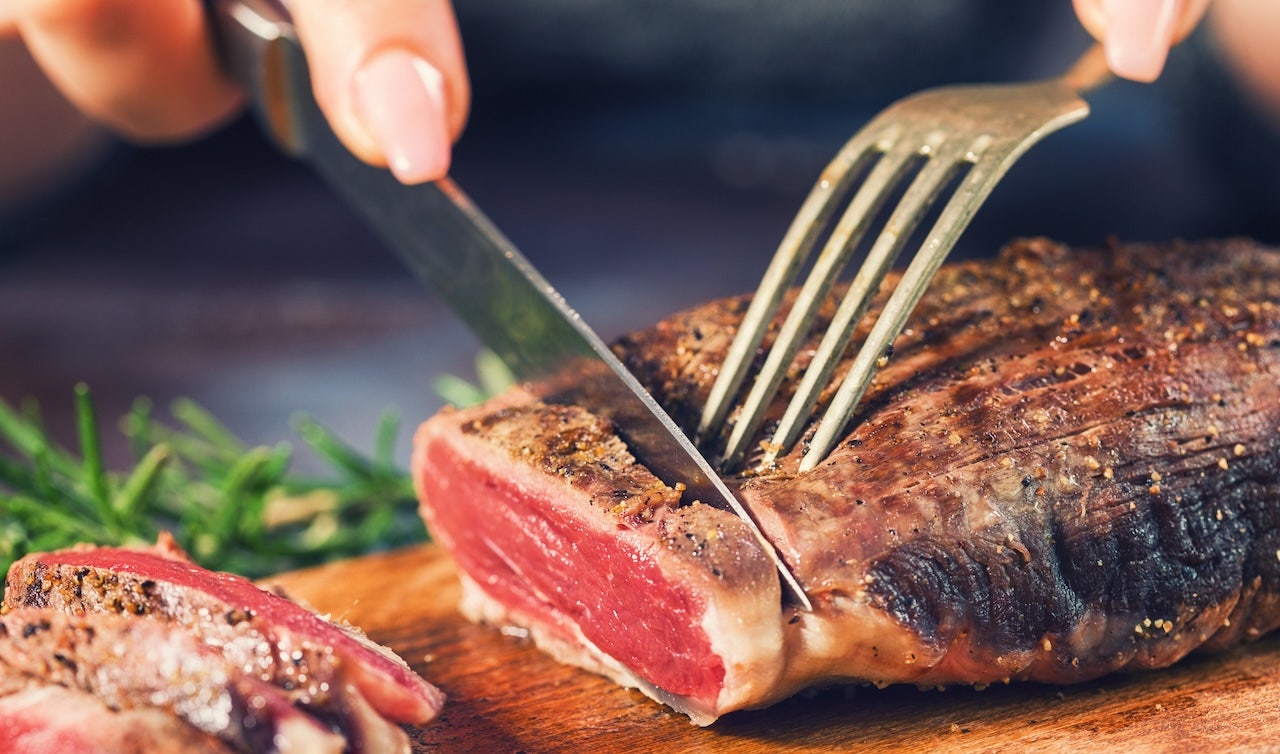Health
Seniors in New York City share New Year’s resolutions for 2024: ‘Never too late’

Regardless of age, there is always the opportunity to set and achieve new goals.
That’s the mindset of three women, all in their 90s, who live at Sunrise at East 56th, a senior living facility in Manhattan, New York.
“It’s never too late to improve yourself,” said Barbara Fleischman, 99, who is originally from Detroit, Michigan.
MOST SENIORS IN AMERICA CAN’T AFFORD NURSING HOMES OR ASSISTED LIVING, STUDY FINDS
Along with Lois Hummel, 90, and Dolores Wharton, 96, Fleischman spoke with Fox News Digital via Zoom about their New Year’s resolutions for 2024.
They also shared some advice for younger generations. Their answers may surprise you.
Goals for New Year include, ‘Accept people’
Fleischman’s biggest New Year’s resolution is to be less judgmental of others.
“I want to assume that everyone is trying to be better, just like I’m trying to be better, and so I’m not going to sit in judgment,” she said.
From left to right, Dolores Wharton, Lois Hummel and Barbara Fleischman are all residents of Sunrise at East 56th, a senior living facility in Manhattan. (Sunrise at East 56th)
“I’m just going to accept people and say, ‘They’re trying.’”
WHEN SHOULD OLDER DRIVERS HAVE TO STOP DRIVING?
Fleischman also aims to stop jumping to conclusions this year, she said.
Her resolutions for 2024 are quite different from the ones she set in years past, she indicated.
“Why do I need restraint? I’m 99.”
For example, she used to resolve to not eat so many sweets — but now she feels she’s earned the right to enjoy her dessert.
“Why do I need restraint? I’m 99,” Fleischman said with a laugh. “I’m having pumpkin pie or mint chocolate ice cream, and enjoying it very much.”

Barbara Fleischman, 99, is pictured with Jim Santana, executive chef at Sunrise at East 56th in Manhattan. (Sunrise at East 56th)
Hummel, who grew up in Pennsylvania, said her primary New Year’s resolution is to continue her focus on staying active.
The day after Christmas, to mark her 90th birthday, she accomplished her longtime goal of walking across the Brooklyn Bridge.
“I couldn’t have done it without my trainer, Doug, and my very close friend, Miriam, who went with us and has a great sense of humor,” Hummel said.
“Acceptance is absolutely the key to happiness — but it’s probably the most difficult thing you could possibly achieve.”
The bridge was quite busy that day and not quite as serene as she expected — but Hummel said she still enjoyed the experience.
Looking ahead, she will continue working with her physical therapist and plans to walk around Roosevelt Island, which is about a mile in circumference, she said.
Like Fleischman, Hummel has also resolved to work on mastering the art of acceptance.
“Acceptance is absolutely the key to happiness — but it’s probably the most difficult thing you could possibly achieve,” she told Fox News Digital. “I try, but I haven’t been very successful at it.”

Dolores Wharton, 96, is pictured with her book, “A Multicultured Life.” Wharton is a retired corporate executive who also ran a nonprofit program to advance the careers of women and minorities. (Sunrise at East 56th)
Wharton, a lifelong New Yorker who’s been close friends with Fleischman for over 50 years, also has a resolution to walk regularly.
“I’m using a walker now, after having been in a wheelchair for a while after a fall last week,” she told Fox News Digital.
“So now I want to be able to walk — not with a walker, but on my own — right into Bergdorf Goodman and Bloomingdale’s, my favorite stores.”
Words of wisdom for all
When asked to share her best advice for younger generations, Fleischman stressed the importance of constantly growing and learning.
“You have to learn from what is happening around you and be smart enough to accept it,” she advised. “Acceptance is very important.”
INTERNET USE BY SENIORS ON REGULAR BASIS COULD SLASH THEIR DEMENTIA RISK, STUDY SUGGESTS
For example, Fleischman said she’s learned to accept the fact that she doesn’t hear or see as well as she once did, and she can’t swim like she used to — but she’s accepted those realities and still considers herself “very lucky.”
Hummel, a retired economist, encourages others to adopt a practice that encourages introspection and reflection.
“The most important thing I ever did for myself was to spend four years doing silent meditation,” she said, a practice that she started in her 60s and wholeheartedly recommends.

Lois Hummel, 90, is pictured crossing the Brooklyn Bridge, which was a longtime goal of hers, she told Fox News Digital. (Sunrise at East 56th)
“It will give you insights into yourself and will serve you for the rest of your life, because you can learn more about acceptance than you can learn any other way.”
She added, “The more you look, the more you see the type of person you really are.”
Hummel also stressed the importance of looking after animals and the environment.
NEW YEAR’S RESOLUTIONS: NO REASON WHY THESE CAN’T INCLUDE FAITH GOALS, URGES PASTOR
Wharton’s advice is for people to “interact harmoniously” with one another.
After working for years on a nonprofit program to advance the careers of women and minorities, she also encourages females “to aspire to go into the corporate world.”

From left to right, Dolores Wharton, Barbara Fleischer and Lois Hummel spoke by video with Fox News Digital from Sunrise at East 56th, a senior living facility in Manhattan, New York. (Sunrise at East 56th)
The three women agreed that giving back to others and to the community should be a primary focus.
Fleischman, who spent many years doing volunteer work, shared a mantra she said her husband used to follow.
“He said if the community has been good to you and you haven’t suffered, you owe something back to it. It’s a joy to help others who haven’t done as well as you have.”
Above all, she added, people should try to be better, whatever that means for them.
“If each individual tries to be better and helpful to others, then the whole world will change.”
“You learn so much by reaching out to others — it’s a wonderful gain.”
Fleischman also advised people to be “less concerned about themselves and more concerned about others,” noting that “self-absorption” is not healthy.
5 WAYS TO STICK WITH YOUR ‘EXERCISE MORE’ NEW YEAR’S RESOLUTION IN 2024, FROM A NEW YORK DOCTOR
“We’re here not only to help ourselves, but to help others,” she said.
“You learn so much by reaching out to others — it’s a wonderful gain. And I hope that will be a resolution for many people.”
Benefits of goal-setting for seniors
New Year’s resolutions are especially important for seniors because they represent looking toward the future, according to Dr. Sandi Petersen, VP of health and wellness at Pegasus Senior Living in Dallas, Texas.
“Seniors should be encouraged to look forward, regardless of age,” she told Fox News Digital.
As a geriatric clinician, Petersen considers this a critical factor in her evaluation of older adults.
“Are they looking forward to the future — or are they feeling isolated, alone or hopeless? If individuals are focused on the future, it’s a sign of mental health, whether they are 9 or 90+,” she noted.

“Seniors should be encouraged to look forward, regardless of age,” a geriatric clinician told Fox News Digital. (iStock)
As some older adults with cognitive decline cannot make resolutions on their own, Petersen stressed the need for their loved ones to engage them in future-oriented conversations to promote socialization and improved quality of life.
“And, given the mind-body connection, we know that improved mental health increases the likelihood of improved physical health and a better sense of overall well-being,” she added.
CLICK HERE TO SIGN UP FOR OUR HEALTH NEWSLETTER
Diana Santiago, clinical supervisor at Caron Treatment Centers in Pennsylvania, noted that future goals for the older adults in her facility are mostly focused on “purpose and quality of life.”
“Family seems most important to these folks, as that is what drives them to seek treatment,” she told Fox News Digital.

A geriatric clinician noted that future goals for the older adults in her facility are mostly focused on “purpose and quality of life.” (iStock)
Some of the most common resolutions among her senior patients include improving relationships with family members, getting physically stronger and healthier, managing anxiety and depression, and managing chronic pain.
“Sometimes goals with this population can even be simply focused on getting home from treatment and seeking to get better quickly,” Santiago said.
“We will use this as a motivation rather than as an obstacle.”
For more Health articles, visit www.foxnews.com/health.

Health
RFK Jr. likely to be confirmed as health secretary, Dr. Siegel says

The confirmation hearing to consider the nomination of Robert F. Kennedy Jr. as Secretary of Health and Human Services (HHS) is expected to take place on Wednesday, Jan. 29.
The highly anticipated hearing follows the introduction of the Make America Healthy Again (MAHA) movement – a campaign to revolutionize health in the country.
On “Fox & Friends” Monday morning, Fox News Senior Medical Analyst Dr. Marc Siegel expressed his confidence in RFK’s confirmation being successful.
TRUMP AND A HEALTHIER AMERICA WELCOMED BY DOCTORS: ‘NEW GOLDEN AGE’
“He’s right in the middle of a really important issue in this country, and it’s why he’s going to get in,” Siegel predicted. “We are not healthy here. We are a sick society.”
Dr. Marc Siegel tells “Fox & Friends” on Jan. 27, 2025, that RFK Jr. will “for sure” be confirmed as HHS secretary. (Fox News)
According to Siegel, 45% of U.S. adults and 20% of children are obese, which can lead to diseases like high blood pressure, heart disease, cancer and diabetes.
The MAHA agenda focuses on nutrition as a key element of creating a healthier nation.
NUTRITIONISTS REACT TO THE RED FOOD DYE BAN
Siegel agreed that “we have to start with the food we eat,” commenting on the health hazards of ultraprocessed foods.
“He’s right in the middle of a really important issue in this country, and it’s why he’s going to get in.”
“So, a little kid says, ‘Let me have that cereal that looks like it came from Mars,’ but it has empty calories in it. It’s got chemicals in it. They get addicted to it, and they don’t eat healthy foods.”
Siegel emphasized the need to bring back a “farm to fork” method of food supply and nutrition.

America’s kids are eating foods that have “empty calories” and are addictive, Siegel warned. (iStock)
“Our farmers will love that,” he said. “We need to support our farmers and go back to organic food – farm to fork – without the chemicals. That’s what Kennedy wants.”
RFK’s movement aims to promote better health through several avenues, including outlawing dyes and additives in food that lead to chronic disease, removing toxins from the environment, combating corporate corruption and supporting regenerative agriculture.
CLICK HERE TO SIGN UP FOR OUR HEALTH NEWSLETTER
Siegel echoed that the goal is to “make people feel better,” which includes weighing less and exercising more.
“I would add to his agenda tax incentives for gym memberships,” the doctor suggested. “You join a gym; you get a tax incentive.”

President Donald Trump’s nominee to be Secretary of Health and Human Services, Robert Kennedy Jr., sits in a meeting with Sen. John Cornyn (R-TX) on Capitol Hill on Jan. 9, 2025, in Washington, DC. (Jon Cherry/Getty Images)
“We are a very sedentary society,” he went on. “Let’s get us exercising again, eating right again, losing weight. The obesity epidemic is causing a huge amount of health issues in this country.”
For more Health articles, visit www.foxnews.com/health
In a separate interview with Fox News Digital, Siegel elaborated that the U.S. has a “sick care system rather than a healthcare system.”
“It is a combination of big insurance and big pharma, which profits when we are ill,” he said.
“If we exercise more and drink less and eat healthier foods, we are going to be healthier.”
Siegel shared how obesity leads to inflammation and other “expensive diseases” that he treats in his own practice, like hypertension, heart disease, diabetes, sleep apnea, stroke, cancer, joint problems, back pain and Alzheimer’s disease.
“If we exercise more and drink less and eat healthier foods, we are going to be healthier, which is an enormous saving in healthcare costs,” he noted.
There should be focus on removing chemicals and dyes in foods, Siegel reiterated, along with a push for less addictive food and freshly grown produce, especially in schools.
The doctor also suggested more emphasis on non-invasive wellness modalities like yoga, acupuncture and chiropractic care.
Health
‘This Is a Dangerous Virus’

When bird flu first struck dairy cattle a year ago, it seemed possible that it might affect a few isolated herds and disappear as quickly as it had appeared. Instead, the virus has infected more than 900 herds and dozens of people, killing one, and the outbreak shows no signs of abating.
A pandemic is not inevitable even now, more than a dozen experts said in interviews. But a series of developments over the past few weeks indicates that the possibility is no longer remote.
Toothless guidelines, inadequate testing and long delays in releasing data — echoes of the missteps during the Covid-19 pandemic — have squandered opportunities for containing the outbreak, the experts said.
In one example emblematic of the disarray, a few dairy herds in Idaho that were infected in the spring displayed mild symptoms for a second time in the late fall, The New York Times has learned. In mid-January, the Department of Agriculture said that no new infections in Idaho herds had been identified since October. But state officials publicly discussed milder cases in November.
That a second bout of infections would produce milder symptoms in cattle is unsurprising, experts said, and could be welcome news to farmers. But reinfections suggest that the virus, called H5N1, could circulate on farms indefinitely, creating opportunities for it to evolve into a more dangerous form — a “high-risk” scenario, said Louise Moncla, an evolutionary biologist at the University of Pennsylvania.
“You could easily end up with endemically circulating H5 in dairy herds without symptoms, obscuring rapid or easy detection,” Dr. Moncla said.
It’s impossible to predict whether the virus will evolve the ability to spread among people, let alone when, she and others said. But the worry is that if bird flu finds the right combination of genetic mutations, the outbreak could quickly escalate.
“I’m still not pack-my-bags-and-head-to-the-hills worried, but there’s been more signals over the past four to six weeks that this virus has the capacity” to set off a pandemic, said Richard Webby, an influenza expert at St. Jude Children’s Research Hospital.
Federal officials, too, have subtly altered their tone in discussing the outbreak, now emphasizing how quickly the situation might change.
For the general public, H5N1 is “a low risk, relative to the other risks they face today,” said Dr. Nirav Shah, principal deputy director of the Centers for Disease Control and Prevention. But “100 percent, that could change,” he said. “This is a dangerous virus.”
Health experts emphasize that there are precautions Americans can take: Do not touch sick or dead birds or other animals; get tested if you have flulike symptoms; do not consume raw milk or meat, or feed them to your pets.
If a larger outbreak were to erupt, the federal vaccine stockpile holds a few million doses, although that vaccine might first need updating to match the evolved form of the virus. In either case, officials would have to scramble to produce enough for the population.
The C.D.C. recommends treatment with the antiviral Tamiflu, but studies have shown that the drug does very little to ease illness.
Underlining concerns among many experts is that Robert F. Kennedy Jr., who would lead the federal health department if confirmed, was a vocal critic of Covid vaccines and has said the bird flu vaccines “appear to be dangerous.”
Even if the second Trump administration embraces vaccine development, as the first one did when Covid bore down, it’s unclear how many Americans would roll up their sleeves for the shots. Influenza typically affects children and older adults, and pandemic influenza has sometimes hit young adults the hardest. But the mistrust engendered during Covid-19 may make Americans eschew precautions, at least initially.
An evolving threat
Unlike the coronavirus, which caused havoc with its sudden arrival, influenza viruses typically start off in a specific animal species or in certain geographical regions.
When H5N1 emerged in East Asia nearly three decades ago, it mostly sickened birds. In the years that followed, it infected at least 940 people, nearly all of whom had close, sustained contact with infected birds; roughly half of those people died.
But since January 2022, when the virus was detected in wild aquatic birds in the United States, it has affected more than 136 million commercial, backyard and wild birds, helping to send egg prices soaring. It has also struck dozens of mammalian species, including cats both wild and domesticated, raccoons, bears and sea lions.
For at least a year, H5N1 has been infecting dairy cattle, which were not known to be susceptible to this type of influenza. In some cows, it has had lasting effects, reducing milk production and increasing the odds of spontaneous abortions.
And in 2024, the virus infected 67 Americans, compared with just one in the years before, in 2022. The sources of these infections are not all known; one person may have transmitted the virus to someone in their household.
Many of these developments are classic steps toward a pandemic, said Dr. James Lawler, a director at the University of Nebraska’s Global Center for Health Security. But, he noted, “where those were really supposed to trigger accelerated and amplified actions at the federal, state and local level, we’ve just kind of shrugged when each milestone has passed.”
Infections in dairy herds, which first emerged in Texas, appeared to be declining last summer. But in late August, California announced its first case. The state’s figures soon rose sharply, prompting Gov. Gavin Newsom to declare a public health emergency in December.
“That was sort of a flag to me, like, ‘OK, this hasn’t gone away,’” said Dr. Manisha Juthani, commissioner of the Connecticut Department of Public Health. “Over the last couple of months, it has felt like the tempo has increased,” she said.
Several other recent events have raised the level of alarm among experts. In early December, scientists reported that in a lab setting, a single mutation helped the virus infect human cells more efficiently.
And late last year two people, a 13-year-old Canadian girl and a Louisiana resident older than 65, became seriously ill; previously, most people infected with H5N1 had not experienced severe symptoms. The Louisiana patient, who had health conditions and cared for sick and dying birds, died in early January.
The girl was placed on life support because of organ failure, but eventually recovered. Scientists still do not know how she became infected; her only risk factor was obesity.
Both patients had contracted a new version of the virus that is distinct from the one in dairy cattle and is now widespread in birds. In both individuals, the virus gained mutations during the course of infection that might allow it to better infect people.
“We are clearly now getting novel viruses forming in the wild bird reservoir,” Dr. Moncla said. “It’s become challenging to keep a handle on all of the various threats.”
Some experts see it as particularly worrisome that the virus seems to be in food sources like raw milk and raw pet food. Domesticated cats have died in numerous states, prompting the recall of at least one brand of pet food and new federal guidelines on pet food quality.
“The raw-pet-food thing to me is, I think, quite alarming,” said Dr. Jeanne Marrazzo, director of the National Institute of Allergy and Infectious Diseases.
Pasteurization kills live virus, as does cooking meat at high temperatures. Still, neither procedure is perfect, Dr. Marrazzo noted: “There’s no way that you can police production and sterilization in a way that’s going to make sure 100 percent of the time that food supply is going to be safe.”
A flawed response
In the year since the outbreak began, federal officials have announced other measures to prevent or prepare for a pandemic. But each is deeply flawed, experts said.
The U.S. Department of Agriculture was slow to begin testing H5N1 vaccines for cows, leaving interested companies in limbo. Dr. Marrazzo said that the department had released genetic information from virus samples but had not said where or when they were collected — details that would help scientists track the virus’s evolution.
It is also unclear how many herds are reinfected or have been battling monthslong infections. In Idaho, some herds infected in the spring seemed to recover but showed milder symptoms again in November.
“From the data we have to date, we do not see evidence of new infections or reinfections in previously affected herds, but rather a lack of clearance of the original infection,” a spokesman for the U.S.D.A. said in an emailed response. But outside experts said that the trajectory of symptoms suggested a second round of illness.
The U.S.D.A.’s program to test bulk milk began in December — nearly a year after the outbreak began — and still does not include Idaho. Engaging private companies may help the program move faster.
Ginkgo Bioworks, a company that worked with federal agencies during the Covid pandemic, already assesses roughly half the nation’s commercial milk supply for bacteria, antibiotics and other substances.
Adding H5N1 to the list would be straightforward, so “why wouldn’t we just add assays into this infrastructure that we already have?” said Matt McKnight, a manager at the company’s biosecurity division.
Earlier this month, the Biden administration announced $306 million in new funding, about one-third of it for surveillance, testing and outreach to farmworkers.
But farmworkers in some places like the Texas Panhandle are still unaware of what bird flu is, how it spreads and why it should matter to them, said Bethany Alcauter, director of research and public health programs at the National Center for Farmworker Health.
As a result, she said, many workers still do not use protective gear, including in milk parlors where the virus is thought to spread.
Human testing has been voluntary, and infections have been missed. Few farmworkers have opted to be tested, out of fear of immigration officials or their own employers.
“If you don’t look for it, you won’t find it, right?,” said Dr. Deborah Birx, who served as White House Coronavirus Response Coordinator under President Trump. “This is not about lockdowns or restricting activity. It’s about protecting the individual American by empowering them with the information.”
Health
Red meat could raise dementia risk, researchers claim, yet some doctors have questions

While red meat is a rich source of protein, iron and other nutrients, a recent study linked it to an increased risk of dementia — but some doctors are casting doubt on the claim.
Researchers from the Harvard T.H. Chan School of Public Health and Mass General Brigham found that daily consumption of certain amounts of processed red meats increased dementia risk by 13%, according to a press release.
It was also tied to a 14% higher risk of developing subjective cognitive decline and faster brain aging.
BRAIN AND MEMORY ARE BOOSTED BY EATING ONE PARTICULAR DIET, STUDY FINDS
“The findings did not really surprise us,” lead study author Yuhan Li, a researcher from Harvard T.H. Chan School of Public Health in Boston, told Fox News Digital.
Researchers from the Harvard T.H. Chan School of Public Health and Mass General Brigham found that daily consumption of certain amounts of processed red meats increased dementia risk, but some doctors are casting doubt. (iStock)
“The results are generally in line with our hypothesis, showing that a higher intake of red meat, particularly processed red meat, is associated with an increased risk of developing dementia and worse cognition.”
The increased risk was seen in people who ate at least one-quarter of a serving of unprocessed meats per day, according to the research article. This equates to around one hot dog, two slices of bacon, or one and a half slices of bologna.
NUTRITIONISTS REACT TO THE RED FOOD DYE BAN: ‘TOOK FAR TOO LONG’
The researchers also suggested that replacing one serving of processed red meat per day with a serving of nuts and legumes could reduce dementia risk by 19% — and that replacing it with fish could reduce the risk by 28%.
The study included 133,771 individuals, 11,173 of whom received a dementia diagnosis over a four-decade span. The data came from the Nurses’ Health Study (NHS) and Health Professionals Follow-Up Study (HPFS), which tracked participants’ dietary choices and health status.

The increased risk was seen in people who ate at least one-quarter of a serving of unprocessed meats per day, which equates to around two slices of bacon, one hot dog, or one and a half slices of bologna. (iStock)
Funded by the National Institutes of Health, the study was published on Jan. 15 in the journal Neurology.
The findings were first presented at the Alzheimer’s Association International Conference (AAIC) earlier in 2024.
Experts react to the findings
“There are many reasons to believe that too much red meat is linked to dementia,” Dr. Marc Siegel, clinical professor of medicine at NYU Langone Health and Fox News senior medical analyst, told Fox News Digital.
“In the case of processed meat like bacon and ham, the chemicals added may also lead to dementia via inflammation and neuroinflammation,” added Siegel, who was not involved in the new research.

The researchers suggested that replacing one serving of processed red meat per day with a serving of nuts and legumes could reduce dementia risk by 19%. (iStock)
The doctor also warned of red meat potentially leading to weight gain and obesity, which can cause inflammation and in turn raise the risk of dementia.
“Red meat may also lead to heart disease, which increases dementia risk,” Siegel noted.
Theresa Gentile, a registered dietitian nutritionist and spokesperson for the Academy of Nutrition and Dietetics in New York, noted that previous research has found an association between red meat — especially processed red meat — and an increased risk of type 2 diabetes and cardiovascular disease, which are both related to impaired cognitive health.
“There isn’t a single food or ingredient that … has been shown to cause, increase risk, prevent, treat or cure Alzheimer’s or other dementias.”
“This was a large study conducted over a long period of time and was adjusted for confounding factors and still found that, in three different groups, eating more processed red meat was associated with cognitive decline than eating less,” Gentile, who did not work on the study, told Fox News Digital.
Some experts suggested that the risk is linked more to ultraprocessed foods in general rather than specific meats.

“The results are generally in line with our hypothesis, showing that a higher intake of red meat, particularly processed red meat, is associated with an increased risk of developing dementia and worse cognition,” said one of the researchers (not pictured). (iStock)
Heather M. Snyder, Ph.D., senior vice president of medical and scientific relations at the Alzheimer’s Association in Chicago, pointed out that a number of studies have suggested that diets with more ultraprocessed foods are bad for brain health.
“For example, a report at the AAIC 2022 found that people who eat large amounts of ultraprocessed foods have a faster decline in cognition,” Snyder, who was not involved in the new study, told Fox News Digital.
DIABETES, HEART DISEASE CASES SKYROCKET — AND SCIENTISTS SUGGEST A KEY REASON
“More than 20% of daily intake of ultraprocessed foods led to a 28% faster decline in global cognitive scores, including memory and verbal fluency.”
It is “unlikely” that one food will have a “significant beneficial or detrimental effect on a disease as complex as Alzheimer’s,” according to Snyder.
“There isn’t a single food or ingredient that, through rigorous scientific research, has been shown to cause, increase risk, prevent, treat or cure Alzheimer’s or other dementias,” she stated.
Potential study limitations
Siegel noted that the study was observational, which means that “no strict conclusions can be drawn.”
“We still need double-blinded, randomized trials to draw more definite conclusions,” he said.

It is “unlikely” that one food will have a “significant beneficial or detrimental effect on a disease as complex as Alzheimer’s,” one expert stated. (iStock)
Lead study author Yuhan also acknowledged the potential limitations.
“The Nurses’ Health Study enrolled female registered nurses, and the Health Professionals Follow-Up Study enrolled U.S. male health professionals,” she told Fox News Digital.
COOKING OIL LINKED TO COLON CANCER IN EARLY STUDY, TIED TO INFLAMMATION
“These participants tend to have higher educational attainment and income levels, and therefore, the study’s generalizability may be limited. In addition, because this study is an observational study, residual confounding remains a possibility.”
Dr. Ken Berry, a family physician and diabetes specialist in Tennessee, was not involved in the study but shared his thoughts on “healthy user bias” potentially skewing the results.

“The people who are eating the least amount of processed meat and the least amount of red meat in these studies — they were also exercising every day,” one doctor noted when speaking about the research. (iStock)
“The people who are eating the least amount of processed meat and the least amount of red meat in these studies — they were also exercising every day,” he said in a video posted on his YouTube channel last week.
“They absolutely did not smoke. They did not drink to excess. They were trying their best to live a healthy life.”
“We still need double-blinded, randomized trials to draw more definite conclusions.”
Research has shown that exercising regularly and eating whole, unprocessed foods can decrease the risk of dementia, Berry noted.
“I don’t think any nutrition expert would argue with that,” he said, but added that there is “no evidence whatsoever” that red meat is linked to higher dementia risk.
Healthy dietary tips
Gentile recommended limiting servings of processed red meats like bacon, sausage, hot dogs and deli meats to less than a quarter of a serving per day, and to consider healthier protein alternatives like fish, nuts, legumes and chicken.
“A balanced diet with moderation in terms of protein sources and serving size is key,” Gentile said. “If your diet is heavy in processed red meats, try swapping one of those servings out for beans, fish or chicken.”

One registered dietitian recommended limiting servings of processed red meats and considering protein alternatives like fish, nuts, legumes and chicken. (iStock)
The nutritionist also suggested including brain-boosting foods each day, like fruits, vegetables, whole grains and healthy fats.
The Alzheimer’s Association has long encouraged eating a balanced diet to help prevent Alzheimer’s disease and all other dementia types, Snyder noted.
CLICK HERE TO SIGN UP FOR OUR HEALTH NEWSLETTER
“That includes foods that are less processed to ensure that our bodies get the needed nutrients, because they’ve been associated with a lower risk of cognitive decline,” she told Fox News Digital.
“As research continues, we may uncover other dietary patterns that increase or decrease our risk.”
Berry pointed out that while he is a self-described “carnivore,” he is not completely “anti-plant.”
“I’m a proponent of a proper human diet, which ranges from low-carb with vegetables and berries and nuts, to keto with a few berries and vegetables and nuts, to ‘ketovore’ with just a little veg for flavor and garnish, all the way to carnivore,” he said in his video.
For more Health articles, visit www.foxnews.com/health
The best diet for any individual should depend on multiple factors, he said, including their overall metabolic health, age, weight, genetics and gut microbiome.
Added Berry, “That’s the proper human diet spectrum.”
-

 Culture1 week ago
Culture1 week agoAmerican men can’t win Olympic cross-country skiing medals — or can they?
-

 Culture1 week ago
Culture1 week agoBook Review: ‘Somewhere Toward Freedom,’ by Bennett Parten
-

 Business1 week ago
Business1 week agoOpinion: Biden delivered a new 'Roaring '20s.' Watch Trump try to take the credit.
-

 News7 days ago
News7 days agoJudges Begin Freeing Jan. 6 Defendants After Trump’s Clemency Order
-

 Business4 days ago
Business4 days agoInstagram and Facebook Blocked and Hid Abortion Pill Providers’ Posts
-

 News3 days ago
News3 days agoHamas releases four female Israeli soldiers as 200 Palestinians set free
-

 Technology1 week ago
Technology1 week agoFake job interview emails installing hidden cryptocurrency mining malware
-

 Politics3 days ago
Politics3 days agoOklahoma Sen Mullin confident Hegseth will be confirmed, predicts who Democrats will try to sink next















